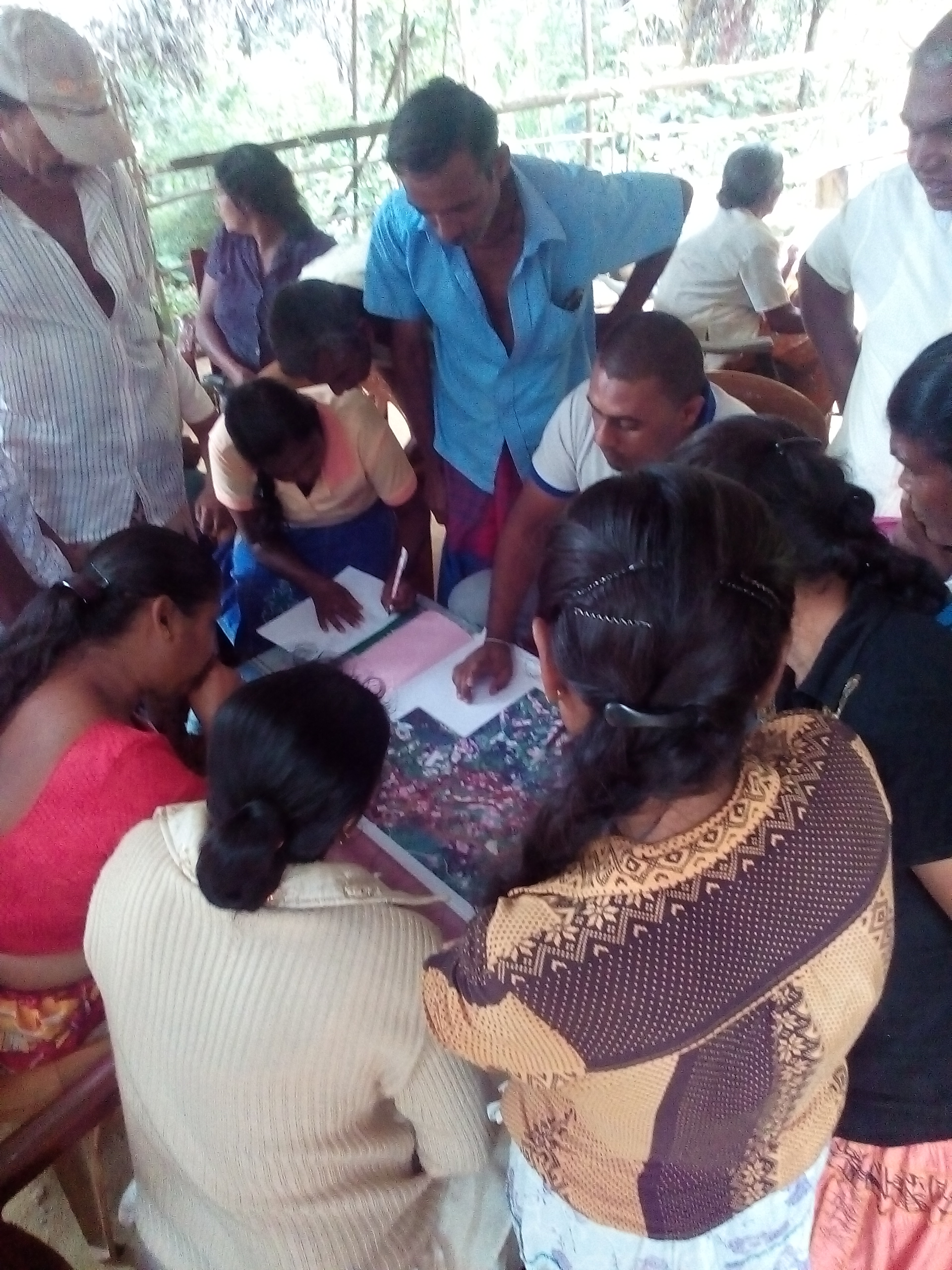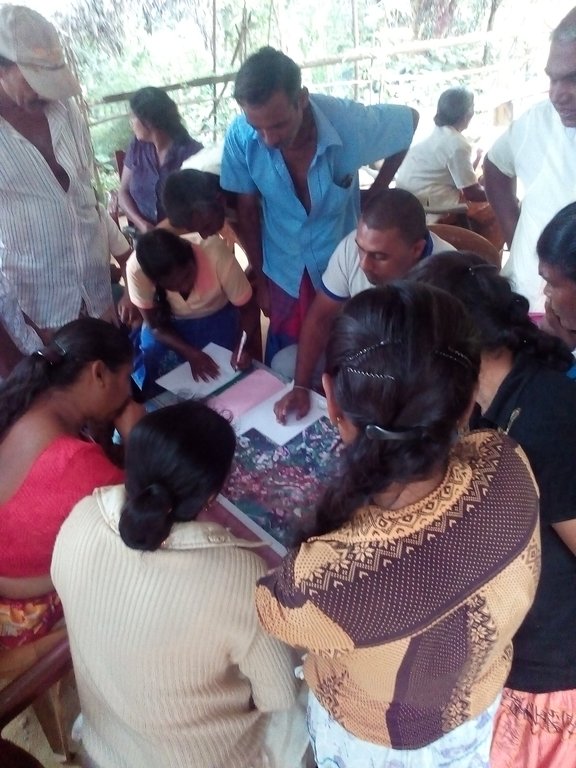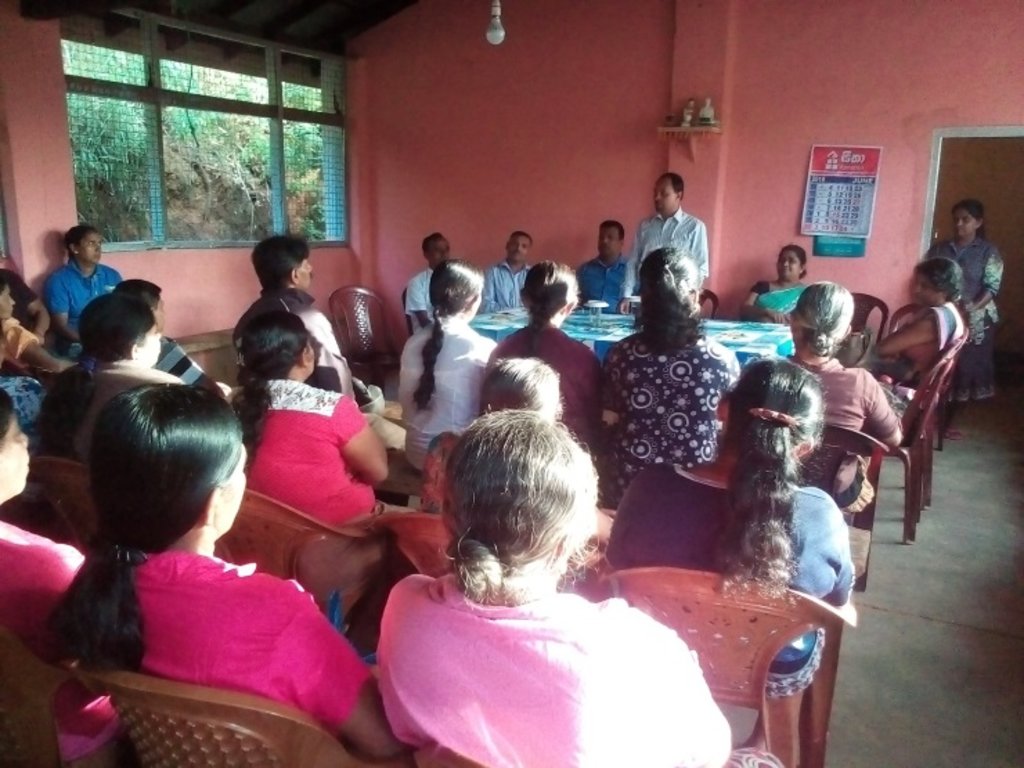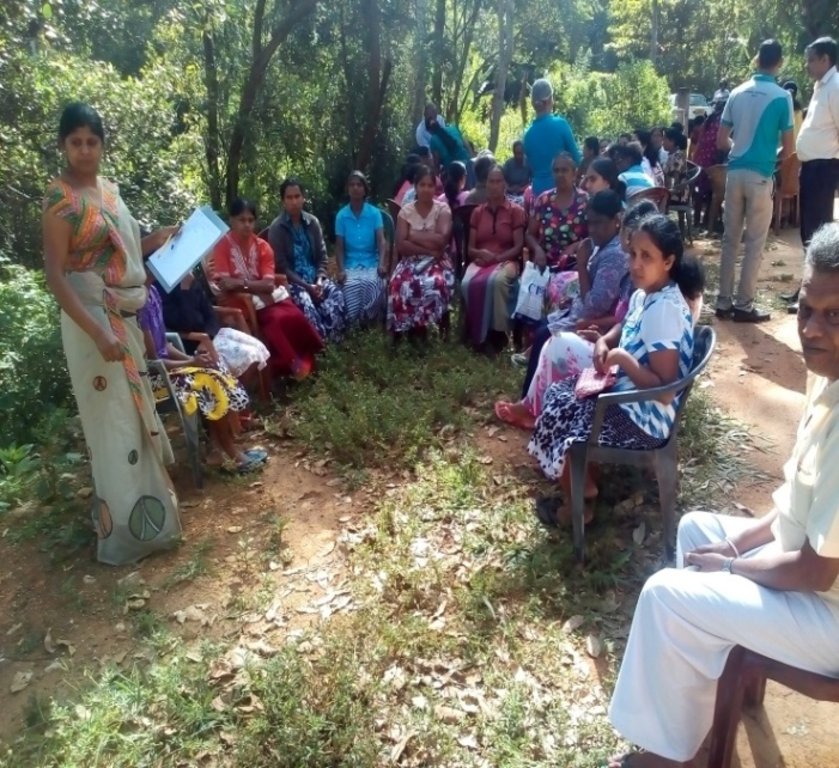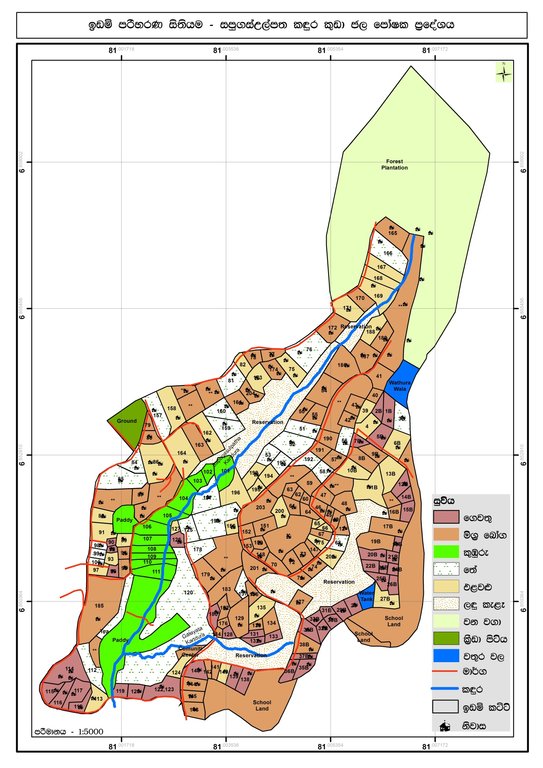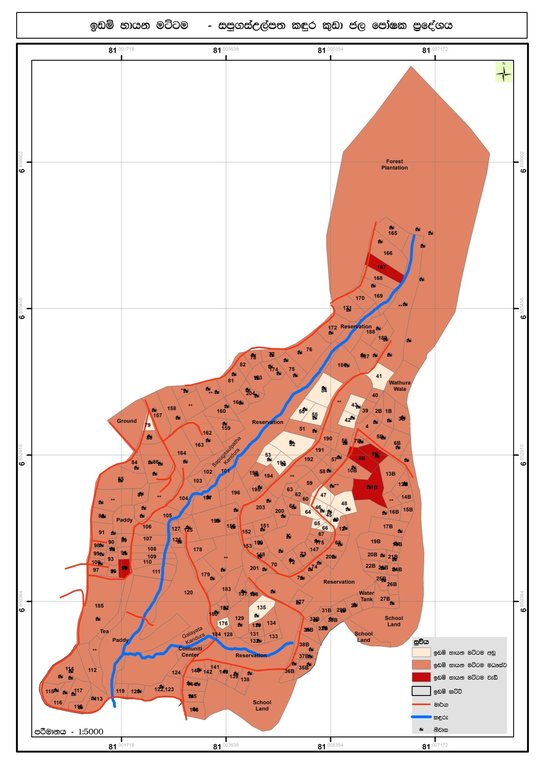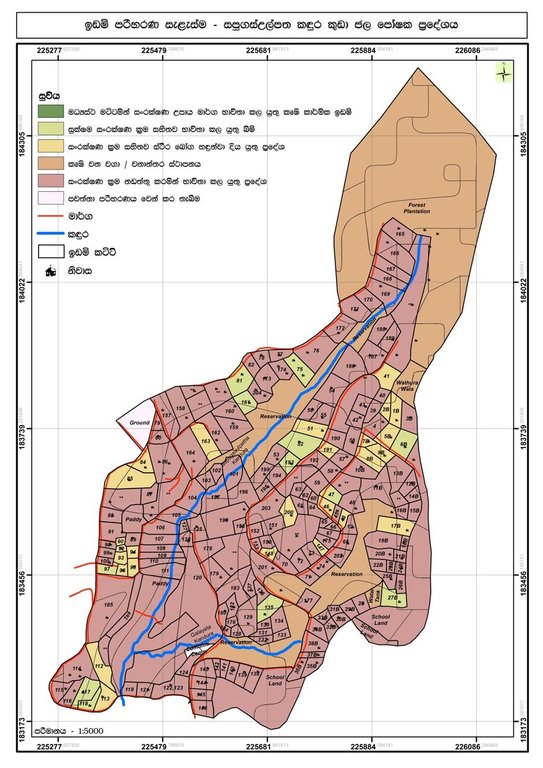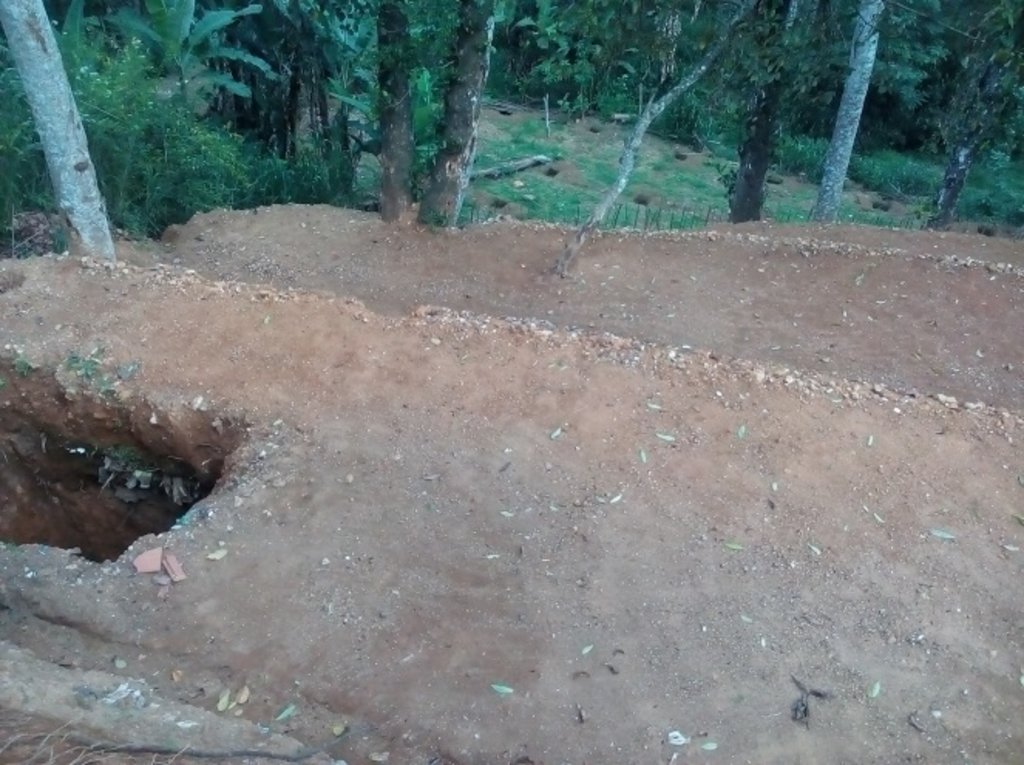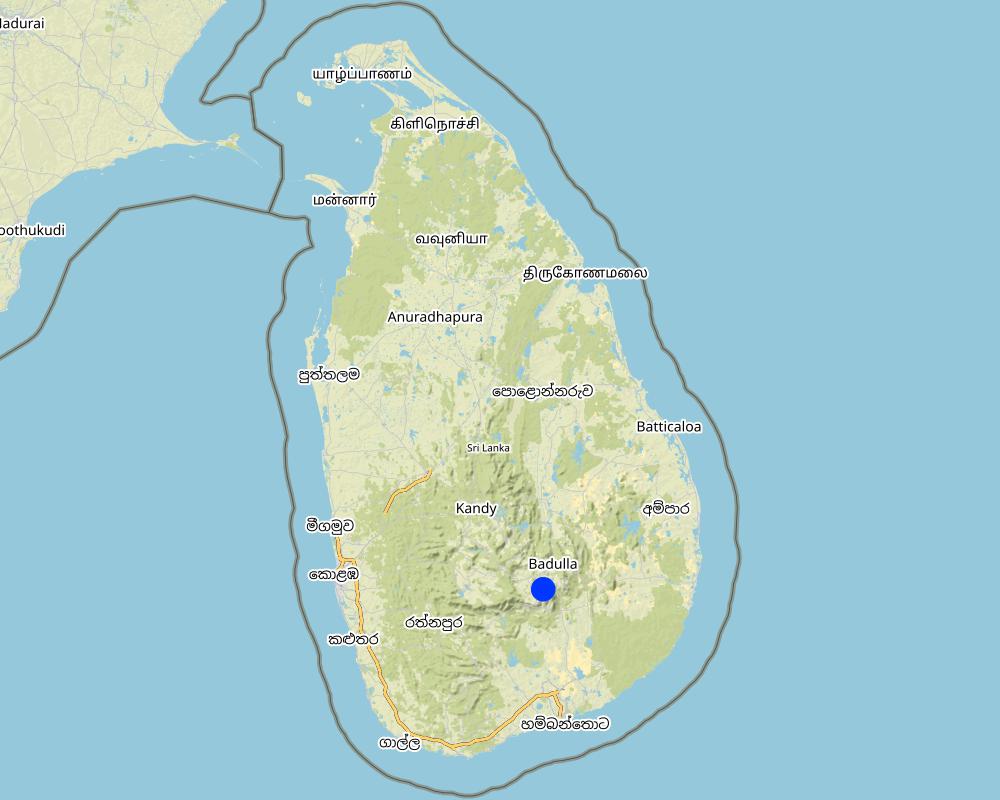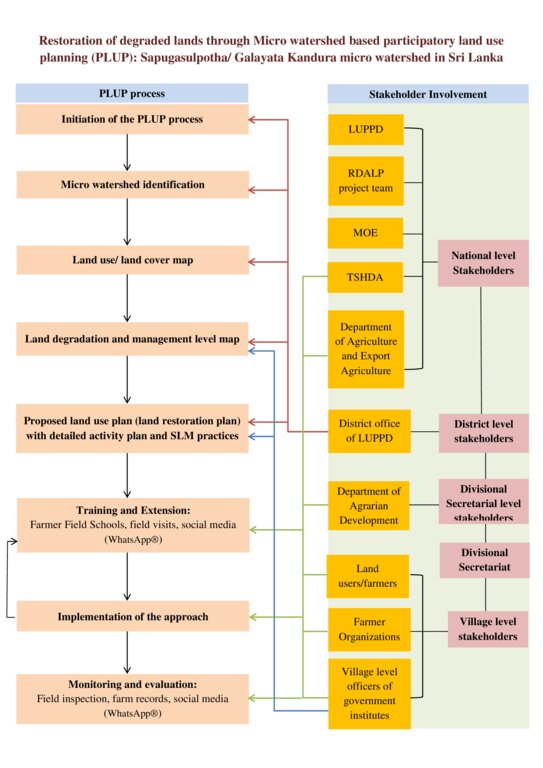Restoration of degraded lands through participatory land use planning [ສິລິ ລານກາ]
- ການສ້າງ:
- ປັບປູງ:
- ຜູ້ສັງລວມຂໍ້ມູນ: Head Soil Science
- ບັນນາທິການ: –
- ຜູ້ທົບທວນຄືນ: William Critchley, Rima Mekdaschi Studer
Village-based participatory land use planning
approaches_6237 - ສິລິ ລານກາ
ເບິ່ງພາກສ່ວນ
ຂະຫຍາຍທັງໝົດ ຍຸບທັງໝົດ1. ຂໍ້ມູນທົ່ວໄປ
1.2 ລາຍລະອຽດ ການຕິດຕໍ່ ຂອງບຸກຄົນທີ່ຊັບພະຍາກອນ ແລະ ສະຖາບັນ ການມີສ່ວນຮ່ວມ ໃນການປະເມີນຜົນ ແລະ ເອກະສານ ຂອງວິທີທາງ
co-compiler:
co-compiler:
Agrarian Research and Production Assistant:
Karunarachchi Mangalika
+94714955038
Department of Agrarian Development
Agrarian Research and Production Assistant Office, Galayata Kandura, Bindunuwewa, Bandarawela.
ສິລິ ລານກາ
ຜູ້ນໍາໃຊ້ທີ່ດິນ:
Podimenike W.M.
+94572232842
Galayata Kandura, Bindunuwewa, Bandarawela.
ສິລິ ລານກາ
ຊື່ຂອງໂຄງການ ທີ່ອໍານວຍຄວາມສະດວກ ໃນການສ້າງເອກກະສານ ຫຼື ປະເມີນດ້ານແນວທາງ (ຖ້າກ່ຽວຂ້ອງ)
Rehabilitation of Degraded Agricultural Lands in Kandy, Badulla and Nuwara Eliya Districts in the Central Highlands of Sri Lankaຊື່ຂອງ ສະຖາບັນການຈັດຕັ້ງ ທີ່ອໍານວຍຄວາມສະດວກ ໃນການສ້າງເອກກະສານ ຫຼື ປະເມີນແນວທາງ (ຖ້າກ່ຽວຂ້ອງ)
Faculty of Agriculture, University of Peradeniya, Sri Lanka (AGRI.PDN) - ສິລິ ລານກາ1.3 ເງື່ອນໄຂ ຂອງການນໍາໃຊ້ເອກກະສານຂໍ້ມູນ ຂອງ WOCAT
ເມື່ອໃດທີ່ໄດ້ສັງລວມຂໍ້ມູນ (ຢູ່ພາກສະໜາມ)?
24/02/2022
ຜູ້ສັງລວມ ແລະ ບັນດາຜູ້ຕອບແບບສອບຖາມ ຍອມຮັບໃນເງື່ອນໄຂ ການນໍາໃຊ້ຂໍ້ມູນເອກະສານ ທີ່ສ້າງຂື້ນ ໂດຍຜ່ານ ອົງການ WOCAT:
ແມ່ນ
2. ພັນລະນາ ແນວທາງການຄຸ້ມຄອງນໍາໃຊ້ດິນແບບຍືນຍົງ
2.1 ການອະທິບາຍ ໂດຍຫຍໍ້ ຂອງວິທີທາງ
Microwatershed-based participatory land use planning is a systematic and interactive process that primarily focuses on the optimal allocation of village land resources according to needs and demands of the people while promoting sustainable land management. Key features of this approach are multi-sectoral coordination, multi-stakeholder engagement and the active participation of land users throughout the participatory land use planning process.
2.2 ການອະທິບາຍ ລາຍລະອຽດ ຂອງວິທີທາງ
ການອະທິບາຍ ລາຍລະອຽດ ຂອງວິທີທາງ:
The Sapugasulpatha/ Galayata Kandura microwatershed is located in Bandarawela Divisional Secretariat (DS), Badulla District, Sri Lanka. Unsustainable land management has led to land degradation causing associated challenges. There was a need to identify strategies for restoration of degraded lands while addressing water scarcity. In 2018, the Rehabilitation of Degraded Agricultural Lands Project (RDALP) introduced participatory land use planning (PLUP) for this microwatershed. Previously, stakeholders were dealt with individually. But the PLUP process relies on the active involvement of all stakeholders. Key is microcatchment level planning - embedded in multi-sectoral coordination and multi-stakeholder engagement.
The process is initiated by the district office of the Land Use Policy Planning Department (LUPPD). Firstly, the LUPPD identifies microwatersheds and develops land use/cover maps. It is assisted by the Bandarawela DS, which is the administrative body for lands in the area and has the capacity to coordinate all relevant stakeholders. Then, officers of the LUPPD meet with community leaders, representatives of farmer organizations and field level officers to verify the land use maps through field visits. Demarcation of individual plots on these maps is also carried out. Next, a field visit is conducted with all stakeholders to identify the status of land degradation and the current crop management practices. This is, effectively, “training of trainers”. Subsequently, the community prepares maps of land degradation and management types with the support of LUPPD.
This is followed by a participatory rural appraisal (PRA) process with all stakeholders. In the PRA, issues related to land degradation/use, ownership, conflicts and socio-economic concerns are discussed. Participants come to an initial consensus on solutions. After this, a detailed action plan is prepared and stakeholders identified. The next stage involves the development of land use plans for the entire microwatershed targeting the restoration of degraded and poorly managed lands. The land use plan covers both on-farm and off-farm land, and provides recommendations for SLM practices over the entire microwatershed: it serves as a detailed land restoration plan. Then, detailed discussions are held with specific stakeholders to prepare sector-based plans. This includes detailed plans for individual farms. As an example, officers of Tea Smallholdings Development Authority (TSHDA) provide inputs to develop detailed plans for smallholder tea cultivation - including plans for individual farmers. Subsequently, implementation is performed jointly by stakeholders. If, for example, a farm is identified for tea cultivation intercropped with export crops, officers both from TSHDA and the Department of Export Agriculture extend their support. The approach includes farmer field schools (FFS) conducted by the Department of Agrarian Development officers and project officers of RDALP. Moreover, farmers are encouraged to use social media (WhatsApp®) to share their knowledge and experiences with SLM practices. The local community is also exposed to examples of good SLM through field visits. The final step is evaluation and monitoring. This is performed by the officers of the Agrarian Service Development, RDALP, and also by individuals. A divisional agricultural committee is mandated to perform continuous monitoring of implementation. PLUP provides the stimulus for farmers to continue SLM - since practices are not enforced but identified themselves. Further, firm bonding is established between land users and other stakeholders, including government institutes, strengthening the likelihood of sustainability.
2.3 ຮູບພາບຂອງແນວທາງ
2.4 ວີດີໂອ ຂອງວິທີທາງ
ຄວາມຄິດເຫັນ, ຄໍາອະທິບາຍຫຍໍ້:
https://youtu.be/uHBRGYVT--M
Participatory Land Use Planning for Sustainable Land Management
ວັນທີ:
03/08/2021
ສະຖານທີ່:
Dambugasagala, Welimada
2.5 ປະເທດ / ເຂດ / ສະຖານທີ່ບ່ອນທີ່ແນວທາງໄດ້ຖືກນໍາໃຊ້
ປະເທດ:
ສິລິ ລານກາ
ພາກພື້ນ / ລັດ / ແຂວງ:
Badulla District - Uva province
ຂໍ້ມູນເພີ່ມເຕີມຂອງສະຖານທີ່:
Watagamuwa Grama Niladhari Division, Bandarawela Divisional Secretariat Division
Map
×2.6 ວັນທີເລີ່ມຕົ້ນ ແລະ ສິ້ນສຸດ ການຈັດຕັ້ງປະຕີບັດ ວິທີທາງ
ສະແດງປີຂອງການເລີ່ມຕົ້ນ:
2018
ປີທີ່ສີ້ນສູດ (ຖ້າຢຸດບໍ່ໄດ້ນໍາໃຊ້ ວິທີທາງ):
2021
ຄວາມຄິດເຫັນ:
Stakeholders continue to provide extension service for this microwatershed, even though the project was finished.
2.7 ປະເພດຂອງແນວທາງ
- ພາຍໃຕ້ໂຄງການ / ແຜນງານ
2.8 ເປົ້າໝາຍ / ຈຸດປະສົງຫຼັກ ຂອງການຈັດຕັ້ງປະຕິບັດ ວິທີທາງ
1)Identification and mapping of degraded lands at microwatershed level.
2)Integration of multi-sectoral coordination and multi-stakeholder engagement in participatory land use planning implemented at village micro watershed level.
3)Identification of land management related issues and factors contributing to land degradation and prioritizing sustainable land use/management options through participatory approach.
4)Development and implementation of a land use plan and an action plan to restore and mitigate the degradation within the micro watershed employing PLUP approach.
5)Maintenance and promotion of ecosystem services for the sustainability of rural livelihoods.
6)Reduction of the pressure of competitive land use on natural resources.
2.9 ເງື່ອນໄຂອໍານວຍ ຫຼື ຂັດຂວາງການປະຕິບັດຂອງເຕັກໂນໂລຢີ / ເຕັກໂນໂລຢີການນໍາໃຊ້ຕາມແນວທາງ
ສັງຄົມ / ວັດທະນະທໍາ / ມາດຕະຖານ ແລະ ຄຸນຄ່າທາງສາສະໜາ
- ອໍານວຍ
Greater social capital as local community is well organized with a strong social bonding among villagers. Farmer organization with leaders appointed by villagers further strengthened the bonding between people for agriculture/ land management related activities.
- ເຊື່ອງຊ້ອນ
Lack of interest of young generation on farming.
ມີຄວາມສາມາດ / ເຂັ້າເຖິງຊັບພະຍາກອນດ້ານການເງິນ ແລະ ການບໍລິການ
- ອໍານວຍ
Having access to a comprehensive land use plan for each land increases access for financial resources such as loan facilities from banks, subsidy schemes of TSHDA, Loan facilities of tea factories. Farmers have the option to come with an agreement with a leading supermarket chain in Sri Lanka to obtain financial services/materials with the promise of supplying the products exclusively to the said supermarket chain.
- ເຊື່ອງຊ້ອນ
Existing financial wellbeing of farmers and land ownership related issues limits the access.
ການກໍ່ຕັ້ງສະຖາບັນ
- ອໍານວຍ
National, regional and village level institutional set up is existing. Moreover, farmer organizations have strengthened the collective power of farmers to coordinate with institutes. Female farmers have formed “Sithamu” Women's Farmers' Organization and both female and male farmers in the village have formed “Galayata Kandura” Rural Farmer Organization. Land use plan serves as a common platform for the collaboration between institutes enhancing the overall synergy.
- ເຊື່ອງຊ້ອນ
Often the lack of coordination between sectoral institutes and top-down approach in decision making. Lack dedicated institutes to coordinate activities at national level.
ການຮ່ວມມື / ການປະສານງານຂອງຜູ້ກ່ຽວຂ້ອງ
- ອໍານວຍ
Officers of relevant government institutes namely, DS, LUPPD, Extension service of the Department of Agriculture, Department of Agrarian Development, Department of Export Agriculture and TSHDA are willingly to support farmers. Moreover, RDALP project officers play an important role in coordinating the activity.
ກ່ຽວກັບກົດໝາຍ (ສິດນໍາໃຊ້ດິນ, ສິດນໍາໃຊ້ນໍ້າ)
- ອໍານວຍ
Majority of farmers own their lands (home gardens and tea smallholdings). Legal frameworks of land ownership and land and water usage are well established.
- ເຊື່ອງຊ້ອນ
Delays and complications in solving legal issues pertaining to land use
ນະໂຍບາຍ
- ອໍານວຍ
Land use policy, soil conservation act, national action plan (NAP) to combat land degradation
- ເຊື່ອງຊ້ອນ
Lack of implementation of policies and acts
ການປົກຄອງທີ່ດິນ (ການຕັດສິນໃຈ, ການປະຕິບັດ ແລະ ຂໍ້ບັງຄັບ)
- ອໍານວຍ
Presence of land use committee (at divisional level) and divisional agriculture committee (included all government institutes related to land use) for decision making. The DS is the chairperson of these committee who is also a part of the PLUP process. Farmers have the liberty to take land use decisions within the framework of land use policy and administrative framework. However, field level officers representing government institutes such as LUPPD, Department of Agriculture, Department of Export Agriculture, TSHDA play a supporting role in implementation of these decisions. Absence of Gender biasedness is a very important factor.
- ເຊື່ອງຊ້ອນ
Land ownerships, conflicts on land ownership, illegal encroachment of sensitive areas of the micro watershed and political interferences
ຄວາມຮູ້ກ່ຽວກັບການຄຸ້ມຄອງ ທີ່ດິນແບບຍືນຍົງ, ການເຂົ້າເຖິງການສະໜັບສະໜູນ ທາງດ້ານວິຊາການ
- ອໍານວຍ
Farmer organizations serve as a platform to share knowledge on SLM. Strong village level extension service is facilitated by the Department of Agriculture, Export Agriculture, TSHDA and other technical services. These officers are available at Agrarian Service Centre and Wednesdays are allocated for meeting with farmers. Moreover, conducting field visits is a part of their duty. Farmer groups have been identified and introduced social media platforms such as WhatsApp® to share SLM knowledge by experts and among themselves. Farmers are capable of operating online interaction facilities such as Zoom® allowing experts to share the knowledge conveniently.
- ເຊື່ອງຊ້ອນ
Inadequacy of extension officers
ຕະຫຼາດ (ໃນການຊື້ວັດຖຸດິບ, ຂາຍຜະລິດຕະພັນ) ແລະ ລາຄາ
- ອໍານວຍ
Farmers have the choice of marketing their products and enter into the value chain i.e. direct selling at the village vegetable market, private companies those visit to the field for purchasing their products (vegetable, spice crops and tea) and intermediate buyers. Farmers also have the option to come into a contract with a leading supermarket chain to sell their products if they are willing to adopt Good Agricultural Practices (GAP).
- ເຊື່ອງຊ້ອນ
Lack of transport facilities, low market price offered by intermediate buyers, price fluctuations
ວຽກ, ມີກໍາລັງຄົນ
- ອໍານວຍ
Most of the SLM practices which are promoted through this approach are not very labor-intensive. Often, family members are sufficient to establish the majority SLM practices.
- ເຊື່ອງຊ້ອນ
Lack of labor force due to the labor migration
3. ການມີສ່ວນຮ່ວມ ແລະ ບົດບາດຂອງພາກສ່ວນທີ່ກ່ຽວຂ້ອງທີ່ໄດ້ມີສ່ວນຮ່ວມ
3.1 ຜູ້ມີສ່ວນຮ່ວມ ໃນວິທີທາງ ແລະ ພາລະບົດບາດ ຂອງເຂົາເຈົ້າ
- ຜູ້ນໍາໃຊ້ດິນໃນທ້ອງຖິ່ນ / ຊຸມຊົນທ້ອງຖິ່ນ
Land users/ village farmers (both men and women)
Express their willingness to involve in PLUP. They are involved in the entire process by actively participating for group discussions and activities with other stakeholders to identify land use related issues, prepare a community land use plan, identify SLM practices and implementation. Further, participation for training programmes and share the knowledge about SLM practices.
- ອົງການຈັດຕັ້ງ ພາຍໃນຊຸມຊົນ
“Sithamu” Women's Farmers' Organization and “Galayata Kandura" Rural Farmer Organization
All farmers of the village are members of these community based organizations. These serve as a platform to promote the involvement of farmers in the PLUP process. Moreover, problems/issues arise in the process are discussed within the organization to come up with socially agreed solutions.
- ຜູ້ຊ່ຽວຊານ ການນຄຸ້ມຄອງ ທີ່ດິນແບບຍືນຍົງ / ທີ່ປຶກສາດ້ານກະສິກໍາ
LUPPD, Department of Agriculture, Department of Export Agriculture, Department of Agrarian Development, TSHDA
Identification of village level micro-catchments by LUPPD
Introducing SLM technologies
Provision of training
Oversee the implementation and monitoring the success of field adopted SLM technologies
- ອໍານາດ ການປົກຄອງທ້ອງຖິ່ນ
DS office of Bandarawela, Department of Agrarian Development, TSHDA, Department of Agriculture and Department of Export Agriculture
Involved in the PLUP process as key stakeholders responsible for advisory services, conflict resolution, capacity building and overall implementation and monitoring
- ພະນັກງານຂັ້ນສູນກາງ (ຜູ້ວາງແຜນ, ຜູ້ສ້າງນະໂຍບາຍ)
LUPPD, Ministry of Environment (MOE), Natural Resource Management Centre of the Department of Agriculture
Support the preparation of land use plans within the context of legal frame work of the country
- ອົງການຈັດຕັ້ງ ສາກົນ
Food and Agriculture Organization (FAO), Global Environment Facility (GEF)
Project coordination, partial financial support, Capacity building
ຖ້າຫາກມີຫຼາຍພາກສ່ວນທີ່ເຂົ້າຮ່ວມ ໃຫ້ລະບຸ ອົງການທີ່ເປັນຫຼັກ ໃນການຈັດຕັ້ງປະຕິບັດ:
LUPPD
3.2 ການມີສ່ວນຮ່ວມຂອງຜູ້ນໍາໃຊ້ທີ່ດິນໃນທ້ອງຖິ່ນ / ຊຸມຊົນທ້ອງຖິ່ນໃນໄລຍະທີ່ແຕກຕ່າງກັນຂອງແນວທາງ
| ການລວບລວມ ເອົາຜູ້ນໍາໃຊ້ດິນ ໃນທ້ອງຖິ່ນ / ຊຸມຊົນທ້ອງຖິ່ນ | ໃຫ້ລະບຸ ຜູ້ໃດທີ່ມີສ່ວນຮ່ວມ ໃນແຕ່ລະກິດຈະກໍາ? | |
|---|---|---|
| ການເລີ່ມຕົ້ນ / ແຮງຈູງໃຈ | ການຮ່ວມມື | Community leaders, LUPPD, DS and RDAL Project officers. The process is initiated by the district office of LUPPD which is the responsible national level authority to prepare sustainable land use plans. The regional office identifies village level micro catchment and develop land use/cover maps. The DS serves as a body that coordinate the activity by linking relevant stakeholders. |
| ການວາງແຜນ | ການຮ່ວມມື | Community leaders, land users, LUPPD, DS and RDALP officers. Planning of the PLUP process is performed by these parties. |
| ການປະຕິບັດ | ການຮ່ວມມື | Land users, community leaders, Department of Agrarian Development, Department of Agriculture, Department of Export Agriculture, TSHDA, officers of RDALP, other officers representing different agriculture sectors and land users. Implementation of the restoration plan for individual farm is performed jointly by different stake holders. As an example if a farmers` land is identified for tea cultivation intercropped with export agricultural crops, officers both from TSHDA and Department of Export Agriculture extend their support for implementation. |
| ຕິດຕາມກວດກາ / ການປະເມີນຜົນ | ການຮ່ວມມື | Land users, Department of Agrarian Development, RDALP officers, individual stakeholders, Department of Agriculture, officers of Natural Resource management Centre and divisional agricultural committee. Please note that participatory monitoring mechanism was implemented. |
| Marketing | ການນໍາໃໍຊ້ເອງ | Land users (farmers), private companies and intermediate sellers. Farmers have the choice of marketing their products by direct selling at the village vegetable market, through private companies those visit to the field for purchasing their products (vegetable and tea) and intermediate buyers. Moreover, farmers also have the option to come into a contract with a leading supermarket chain to sell their products if they are willing to adopt Good Agricultural Practices (GAP) |
3.3 ແຜນວາດ (ຖ້າມີ)
ການອະທິບາຍ:
The PLUP described above is focused on restoration of degraded lands at microwatershed level. The multi-sectoral coordination and multi-stakeholder engagement throughout the process are key features of this process leading to the preparation of detailed restoration plan at on-farm and off-farm levels promoting sustainable land management.
ຜູ້ຂຽນ:
Prof. W.A.U. Vitharana
3.4 ການຕັດສິນໃຈກ່ຽວກັບການຄັດເລືອກເຕັກໂນໂລຢີຂອງການຄຸ້ມຄອງທີ່ດິນແບບຍືນຍົງ / ເຕັກໂນໂລຢີ
ລະບຸ ຄົນທີ່ຕັດສິນໃຈ ກ່ຽວກັບການຄັດເລືອກຂອງ ເຕັກໂນໂລຢີ / ເຕັກໂນໂລຢີ ຈະໄດ້ຮັບການປະຕິບັດ:
- ພາກສ່ວນກ່ຽວຂ້ອງທັງໝົດ, ເປັນສ່ວນໜຶ່ງ ຂອງວິທີທາງແບບມີສ່ວນຮ່ວມ
ອະທິບາຍ:
This is a participatory approach in which stakeholders make collective decisions on the selection of appropriate technologies. Multi-stakeholder engagement is a prominent characteristic.
Specify on what basis decisions were made:
- ປະເມີນເອກກະສານ ຄວາມຮູ້ກ່ຽວກັບ ການຄຸ້ມຄອງ ທີ່ດິນແບບຍືນຍົງ (ຫຼັກຖານທີ່ຊ່ວຍໃນການຕັດສິນໃຈ)
- ຜົນທີ່ໄດ້ຮັບ ຈາກການຄົ້ນຄວ້າ
- ປະສົບການສ່ວນບຸກຄົນ ແລະ ຄວາມຄິດເຫັນ (ທີ່ບໍ່ເປັນເອກກະສານ)
4. ການສະໜັບສະໜູນທາງດ້ານວິຊາການ, ການສ້າງຄວາມສາມາດ, ແລະ ການຈັດການຄວາມຮູ້.
4.1 ການສ້າງຄວາມສາມາດ / ການຝຶກອົບຮົມ
ຜູ້ນໍາໃຊ້ທີ່ດິນ ຫຼື ພາກສ່ວນກ່ຽວຂ້ອງອື່ນໆ ໄດ້ຮັບການຝຶກອົບຮົມບໍ່?
ແມ່ນ
ໃຫ້ລະບຸ ຜູ້ໃດທີ່ໄດ້ຮັບການຝຶກອົບຮົມ:
- ຜູ້ນໍາໃຊ້ດິນ
- ພະນັກງານພາກສະໜາມ / ທີ່ປຶກສາ
ຖ້າເປັນໄປໄດ້, ໃຫ້ລະບຸເພດ, ອາຍຸ, ສະຖານະພາບ, ຊົນເຜົ່າ, ແລະ ອື່ນໆ:
Training was provided for both men and women farmers of the microwatershed
ຮູບແບບຂອງການຝຶກອົບຮົມ:
- ຕົວຕໍ່ຕົວ
- ເນື້ອທີ່ສວນທົດລອງ
- ກອງປະຊຸມ
ຮູບແບບຂອງການຝຶກອົບຮົມ:
- social media (WhatsApp®) and online meetings via Zoom® platform
ໃນຫົວຂໍ້:
Sustainable Land Management practices, compost preparation, liquid fertilizer preparation, water harvesting techniques, soil conservation practices and pruning of fruit trees
ຄວາມຄິດເຫັນ:
Farmers have shown a great interest on sharing knowledge and experiences through the social media
4.2 ການບໍລິການໃຫ້ຄໍາປຶກສາ
ເຮັດຜູ້ໃຊ້ທີ່ດິນມີການເຂົ້າເຖິງການບໍລິການໃຫ້ຄໍາປຶກສາ?
ແມ່ນ
ລະບຸວ່າການສະໜອງ ການບໍລິການ ໃຫ້ຄໍາປຶກສາ:
- ໃນພື້ນທີ່ຂອງຜູ້ນໍາໃຊ້ດິນ
- ສູນຄົ້ນຄວ້າ
ອະທິບາຍ / ຄວາມຄິດເຫັນ:
Well organized advisory service is available in Sri Lanka which is conducted through the field officers of the Department of Agriculture, Export Agriculture, TSHDA. These officers are available at Agrarian Service Centre and Wednesdays are allocated for meeting with farmers and making field visits is a part of their job. Moreover, members of the project team RDALP also served as trainers. Importantly, community leaders and farmer organization representatives were trained as trainers to assure the sustainability.
4.3 ສະຖາບັນການສ້າງຄວາມເຂັ້ມແຂງ (ການພັດທະນາອົງການຈັດຕັ້ງ)
ສະຖາບັນ ໄດ້ຮັບການສ້າງຕັ້ງຂື້ນ ຫຼື ໄດ້ຮັບການສ້າງຄວາມເຂັ້ມແຂງ ໂດຍການຈັດຕັ້ງປະຕິບັດ ວິທີທາງບໍ່?
- ມີ, ພໍສົມຄວນ
ລະບຸ ທາງສະຖາບັນ ໄດ້ສ້າງຄວາມເຂັ້ມແຂງ ໃນລະດັບໃດ (ຫຼາຍ):
- ທ້ອງຖິ່ນ
- ລະດັບພາກພື້ນ
ອະທິບາຍ ສະຖາບັນການຈັດຕັ້ງ, ພາລະບົດບາດ ແລະ ໜ້າທີ່ຮັບຜິດຊອບ, ສະມາຊິກ ແລະ ອື່ນໆ.
The PLUP process strengthens the institutional coordination and their roles at village level.
ລະບຸ ປະເພດ ຂອງສະໜັບສະໜູນ:
- ທາງດ້ານການເງິນ
- ການສ້າງຄວາມອາດສາມາດ / ການຝຶກອົບຮົມ
- ອຸປະກອນ
- infrastructure
ໃຫ້ລາຍລະອຽດເພີ່ມເຕີມ:
Details are provided in Table 6.3
4.4 ຕິດຕາມກວດກາ ແລະ ປະເມີນຜົນ
ການຈັດຕັ້ງປະຕິບັດ ວິທີທາງ ໄດ້ມີການປະເມີນຜົນ ແລະ ຕິດຕາມບໍ?
ແມ່ນ
ຄວາມຄິດເຫັນ:
Field level government officers are entrusted with the monitoring process with the participation of land users
ຖ້າແມ່ນ, ເອກກະສານສະບັບນີ້ ແມ່ນໄດ້ນໍາໃຊ້ເຂົ້າໃນການຕິດຕາມ ແລະ ປະເມີນຜົນບໍ່?
ບໍ່ແມ່ນ
4.5 ການຄົ້ນຄວ້າ
ນີ້້ແມ່ນສ່ວນໜຶ່ງ ການຄົ້ນຄວ້າ ຂອງວິທີທາງບໍ່?
ບໍ່ແມ່ນ
5. ການສະໜັບສະໜູນທາງດ້ານການເງິນ ແລະ ອຸປະກອນຈາກພາຍນອກ
5.1 ງົບປະມານປະຈໍາປີ ສໍາລັບວິທີທາງ ຂອງການຄຸ້ມຄອງ ທີ່ດິນແບບຍືນຍົງ
ຖ້າຫາກບໍ່ຮູ້ຈັດງົບປະມານທີ່ແນ່ນອນ ແມ່ນໃຫ້ປະມານເອົາ:
- 10,000-100,000
ຄໍາເຫັນ (ຕົວຢ່າງ: ແຫຼ່ງຂໍ້ມູນຫຼັກ ຂອງການສະໜອງທຶນ / ຜູ້ໃຫ້ທຶນທີ່ສໍາຄັນ):
GEF and local government institutions
5.2 ການສະໜັບສະໜູນ ທາງດ້ານການເງິນ / ອຸປະກອນ ສະໜອງໃຫ້ແກ່ຜູ້ນໍາທີ່ດິນ
ຜູ້ນໍາໃຊ້ດິນ ໄດ້ຮັບການສະໜັບສະໜູນ ທາງດ້ານ ການເງິນ / ອຸປະກອນ ໃນການຈັດຕັ້ງປະຕິບັດ ເຕັກໂນໂລຢີບໍ?
ແມ່ນ
ຖ້າແມ່ນ, ໃຫ້ລະບຸປະເພດ (ຫຼາຍ) ຂອງການສະໜັບສະໜູນ, ເງື່ອນໄຂ ແລະ ຜູູ້ສະໜອງ (ຫຼາຍ):
Financial support for soil conservation, materials for preparation of nursery sheds (4x4 feet), vegetable seeds and fruit plants for home gardening, tea seedlings for infilling and polythene for rain water harvesting ponds
5.3 ເງິນສົມທົບສໍາລັບການນໍາໃຊ້ສະເພາະປັດໃຈຂາເຂົ້າໃນການຜະລີດກະສິກໍາ (ລວມທັງແຮງງານ)
- ແຮງງານ
| ທີ່ຂອບເຂດ | ລະບຸ ການອຸດໜູນ |
|---|---|
| ງົບປະມານບາງສ່ວນ | Subsidy for establishment of soil conservation structures |
- ອຸປະກອນ
| ໃຫ້ລະບຸໄດ້ຮັບການສະໜັບສະໜູນປັດໃຈຂາເຂົ້າຫຍັງແດ່ | ທີ່ຂອບເຂດ | ລະບຸ ການອຸດໜູນ |
|---|---|---|
| ເຄື່ອງກົນຈັກ | ງົບປະມານເຕັມສ່ວນ | Pruning kits for fruit tree management, Portable hole drilling machine* for establishment of tea plantations, Bush cutters*, selective plucking machines. *Provided for the Village farmer society |
| ເຄື່ອງມື | ງົບປະມານເຕັມສ່ວນ | Nursery trays |
- ກະສິກໍາ
| ໃຫ້ລະບຸໄດ້ຮັບການສະໜັບສະໜູນປັດໃຈຂາເຂົ້າຫຍັງແດ່ | ທີ່ຂອບເຂດ | ລະບຸ ການອຸດໜູນ |
|---|---|---|
| ແນວພັນ, ແກ່ນພັນ | ງົບປະມານເຕັມສ່ວນ | Vegetables seeds |
| Fruit plants, Tea seedlings | ງົບປະມານເຕັມສ່ວນ | Fruit plants for home gardening and intercropped with tea, tea seedling for infilling |
- ການກໍ່ສ້າງ
| ໃຫ້ລະບຸໄດ້ຮັບການສະໜັບສະໜູນປັດໃຈຂາເຂົ້າຫຍັງແດ່ | ທີ່ຂອບເຂດ | ລະບຸ ການອຸດໜູນ |
|---|---|---|
| UV treated Polyethene | ງົບປະມານເຕັມສ່ວນ | UV treated Polyethene for water harvesting ponds and nursery sheds |
- ພື້ນຖານໂຄງລ່າງ
| ໃຫ້ລະບຸໄດ້ຮັບການສະໜັບສະໜູນປັດໃຈຂາເຂົ້າຫຍັງແດ່ | ທີ່ຂອບເຂດ | ລະບຸ ການອຸດໜູນ |
|---|---|---|
| Rainwater storage tank | ງົບປະມານເຕັມສ່ວນ | Rainwater storage tank to harness water for micro watershed and the downstream areas as ground water |
ຖ້າແຮງງານ ຂອງຜູ້ນໍາໃຊ້ດິນ ໄດ້ຮັບການສະໜັບສະໜູນ ປັດໃຈຂາເຂົ້າ, ແມ່ນບໍ່:
- ການອາສາ
ຄວາມຄິດເຫັນ:
Most of the time family members are engaged with field activities
5.4 ສິນເຊື່ອ
ໄດ້ປ່ອຍສິນເຊື່ອ ສະໜອງໃຫ້ພາຍໃຕ້ ວິທີການສໍາລັບກິດຈະກໍາ ການຄຸ້ມຄອງ ທີ່ດິນແບບຍືນນຍົງບໍ່?
ບໍ່ແມ່ນ
5.5 ສິ່ງຈູງໃຈ ຫຼື ເຄື່ອງມືອື່ນໆ
ການສົ່ງເສີມ ຈັດຕັ້ງປະຕິບັດ ເຕັກໂນໂລຢີ ໃນການຄຸ້ມຄອງ ດິນແບບຍືນຍົງ ໄດ້ສະໜອງສິ່ງກະຕຸກຊຸກຍູ້ບໍ່?
ແມ່ນ
ຖ້າແມ່ນ, ໃຫ້ລະບຸ:
Land use policy and agriculture policy of Sri Lanka are overarching instruments. Moreover, regulations identified in the Soil Conservation Act of Sri Lanka promote SLM technologies.
6. ວິເຄາະຜົນກະທົບ ແລະ ສັງລວມບັນຫາ
6.1 ຜົນກະທົບຂອງແນວທາງ
ວິທີທາງ ຊ່ວຍຊຸກຍູ້ ຜູ້ນຳໃຊ້ທີ່ດິນທ້ອງຖີ່ນ, ໃນການປັບປຸງ ການມີສ່ວນຮ່ວມ ຂອງຜູ້ທີ່ກ່ຽວຂ້ອງ ບໍ່?
- ບໍ່
- ມີ, ໜ້ອຍໜຶ່ງ
- ມີ, ພໍສົມຄວນ
- ມີ, ຫຼາຍ
All land users are part of the approach which empowered land users on knowledge on land degradation, SLM practices and preparation of detailed restoration plan for degraded/poorly management lands. Moreover, training programs and field visits empowered land users with specific skills.
ການນໍາໃຊ້ ວິທີທາງ ດັ່ງກ່າວນີ້ ສາມາດເປັນຫຼັກຖານ ທີ່ສະໜັບສະໜູນ ໃຫ້ການຕັດສິນໃຈໄດ້ບໍ່?
- ບໍ່
- ມີ, ໜ້ອຍໜຶ່ງ
- ມີ, ພໍສົມຄວນ
- ມີ, ຫຼາຍ
The participatory approach includes field visits, analysis of field evidences to identify degraded lands and lands those have not been properly managed. These allow land users on evidence based decision making to implement SLM practices.
ການຈັດຕັ້ງປະຕິບັດ ວິທີທາງ ສາມາດຊ່ວຍຜູ້ນໍາໃຊ້ທີ່ດິນ ໃນການຈັດຕັ້ງປະຕິບັດ ແລະ ບໍາລຸງຮັກສາ ເຕັກໂນໂລຢີ ການຄຸ້ມຄອງ ທີ່ດິນແບບຍືນຍົງໄດ້ບໍ?
- ບໍ່
- ມີ, ໜ້ອຍໜຶ່ງ
- ມີ, ພໍສົມຄວນ
- ມີ, ຫຼາຍ
The entire process help land users to understand user specific sustainable land management options and also integrate local knowledge and experience. Since SLM options are identified by land users it enables them to implement based on available resources. Involvement relevant stakeholders (e.g. Agriculture extension officers) and training programs help land users for the implementation and maintenance of SLM technologies. Partial financial support and material support further help farmers to implement and maintain SLM practices.
ການນໍາໃຊ້ ວິທີທາງ ສາມາດປັບປຸງ ການປະສານງານ ແລະ ຄ່າໃຊ້ຈ່າຍ ການຈັດຕັ້ງປະຕິບັດ ທີ່ມີປະສິດທິພາບ ຂອງການຄຸ້ມຄອງ ທີ່ດິນແບບຍືດຍົງໄດ້ບໍ່?
- ບໍ່
- ມີ, ໜ້ອຍໜຶ່ງ
- ມີ, ພໍສົມຄວນ
- ມີ, ຫຼາຍ
Multi-sectoral coordination embedder throughout the process improve coordination among stakeholders. The SLM practices which are identified by land users assured to be cost-effective and manageable.
ການນໍາໃຊ້ ວິທີທາງ ສາມາດລະດົມ ຫຼື ປັບປຸງ ການເຂົ້າເຖິງຊັບພະຍາກອນ ການເງິນ ສໍາລັບການຈັດຕັ້ງປະຕິບັດ ການຄຸ້ມຄອງ ທີ່ດິນແບບຍືດຍົງໄດ້ບໍ່?
- ບໍ່
- ມີ, ໜ້ອຍໜຶ່ງ
- ມີ, ພໍສົມຄວນ
- ມີ, ຫຼາຍ
Involvement of key institutes in the process and documentary evidence on proposed activities enhance the access to financial resources for SLM implementation.
ການນໍາໃຊ້ ວິທີທາງ ສາມາດປັບປຸງຄວາມຮູ້ ແລະ ຄວາມສາມາດຂອງຜູ້ນໍາໃຊ້ທີ່ດິນ ໃນການປະຕິບັດ ການຄຸ້ມຄອງ ທີ່ດິນແບບຍືດຍົງໄດ້ບໍ່?
- ບໍ່
- ມີ, ໜ້ອຍໜຶ່ງ
- ມີ, ພໍສົມຄວນ
- ມີ, ຫຼາຍ
Land users are trained on SLM by providing on-ground hands on experience and through online sessions. Farmers are motivated from others who have already implemented SLM practices.
ການນໍາໃຊ້ ວິທີທາງ ສາມາດປັບປຸງຄວາມຮູ້ ແລະ ຄວາມສາມາດ ຂອງພາກສ່ວນທີ່ກ່ຽວຂ້ອງໄດ້ບໍ່?
- ບໍ່
- ມີ, ໜ້ອຍໜຶ່ງ
- ມີ, ພໍສົມຄວນ
- ມີ, ຫຼາຍ
Interaction between stakeholders is a dominant activity throughout the process. This allows knowledge sharing leading to improve capacities of all stakeholders. FAO officers, Extension officers and officers of Department of Agrarian Development visit each land plot and give further instructions
ການນໍາໃຊ້ ວິທີທາງ ສາມາດສ້າງຄວາມເຂັ້ມແຂງ ໃຫ້ສະຖາບັນການຈັດຕັ້ງ, ການຮ່ວມມື ລະຫວ່າງພາກສ່ວນທີ່ກ່ຽວຂ້ອງບໍ່?
- ບໍ່
- ມີ, ໜ້ອຍໜຶ່ງ
- ມີ, ພໍສົມຄວນ
- ມີ, ຫຼາຍ
Multiple institutions are involved in this approach and they work together in the process of land use planning.
ການນໍາໃຊ້ ວິທີທາງ ໄດ້ປັບປຸງ ການຄໍ້າປະກັນສະບຽງອາຫານ ຫຼື ປັບປຸງໂຄສະນາການໄດ້ບໍ່?
- ບໍ່
- ມີ, ໜ້ອຍໜຶ່ງ
- ມີ, ພໍສົມຄວນ
- ມີ, ຫຼາຍ
Increased production of vegetables and fruits through appropriate land use planning and SLM practices enhance the village level food security
ການນໍາໃຊ້ ວິທີທາງ ໄດ້ປັບປຸງ ການເຂົ້າເຖິງນໍ້າ ແລະ ສາຂາພິບານໄດ້ບໍ່?
- ບໍ່
- ມີ, ໜ້ອຍໜຶ່ງ
- ມີ, ພໍສົມຄວນ
- ມີ, ຫຼາຍ
Establishment of rainwater harvesting ponds has been integrated to land use plan. Further, establishment of village level water harvesting tank increase the ground water status. This lead to access for irrigation water during the dry season.
ການຈັດຕັ້ງປະຕິບັດ ວິທີທາງ ສາມາດສ້າງຄວາມອາດສາມາດໃຫ້ຜູ້ນໍາໃຊ້ດິນ ໃນການປັບຕົວ ຕໍ່ການປ່ຽນແປງດິນຟ້າອາກາດ / ຫຼດຜ່ອນຄວາມສ່ຽງທາງໄພພິບັດໄດ້ບໍ? :
- ບໍ່
- ມີ, ໜ້ອຍໜຶ່ງ
- ມີ, ພໍສົມຄວນ
- ມີ, ຫຼາຍ
Soil conservation practices and SLM practices lead to enhancement of soil organic carbon levels. Further, rainwater harvesting ponds sustain the water supply during extreme drought periods. These will contribute to the enhance climate resilience potential.
ການນໍາໃຊ້ ວິທີທາງ ໄດ້ປັບປຸງ ການຈ້າງງານ, ໂອກາດ ໃນການສ້າງລາຍຮັບບໍ່?
- ບໍ່
- ມີ, ໜ້ອຍໜຶ່ງ
- ມີ, ພໍສົມຄວນ
- ມີ, ຫຼາຍ
Increase in farmer income is expected through appropriate land use planning and application of SLM practices. Especially, crop diversification options introduced and increased irrigation water availability through rain water harvesting will enhance income opportunities. E.g. intercropping of spice crops (export agricultural crops) with tea as one of the consequences of this approach
6.2 ແຮງຈູງໃຈຫຼັກຂອງຜູ້ນໍາໃຊ້ທີ່ດິນໃນການປະຕິບັດການຄຸ້ມຄອງທີ່ດິນແບບຍືນຍົງ
- ການຜະລິດເພີ່ມຂຶ້ນ
Increased production from home gardens and tea smallholdings
- ກໍາໄລເພີ່ມຂຶ້ນ (ຄວາມສາມາດ), ການປັບປຸງຄ່າໃຊ້ຈ່າຍ, ຜົນປະໂຫຍດ, ອັດຕາສ່ວນ
Increased crop yields, thus profits are expected through proper land allocation and application of SLM practices
- ຫຼຸດຜ່ອນດິນເຊື່ອມໂຊມ
Reduced land degradation (specially soil erosion) achieved through SLM practices such as application of soil conservation measures (stone bunds, terraces, contour farming) and application of organic fertilizers (compost) produced by farmers.
- ຫຼຸດຜ່ອນຄວາມສ່ຽງຂອງໄພພິບັດ
Soil conservation practices reduce the risk of earth slips which are prevalent in the area. Rainwater harvesting ponds reduce the risk of droughts.
- ການຊໍາລະເງິນ / ເງິນອຸດໜູນ
Subsidies were provided to implement soil conservation practices. Material support was provided for the preparation of rain water harvesting ponds, establishment of nurseries, and operations in tea lands.
- ການປັບປຸງ ຄວາມຮູ້ ແລະ ຄວາມສາມາດ ຂອງການຄຸ້ມຄອງ ທີ່ດິນແບບຍືນຍົງ
Land users understand the importance of SLM application for their lands through participatory approach and farmer field schools.
- ການປັບປຸງຄວາມງົດງາມ
Aesthetic value of home gardens were improved and it is given extra income for the family.
6.3 ຄວາມຍືນຍົງຂອງກິດຈະກໍາວິທີທາງ
ຜູ້ນໍາໃຊ້ ທີ່ດິນ ສາມາດສືບຕໍ່ ການຈັດຕັ້ງປະຕິບັດ ຜ່ານວິທີທາງໄດ້ບໍ່ (ໂດຍປາດສະຈາກ ການຊ່ວຍເຫຼືອ ຈາກພາກສ່ວນພາຍນອກ)?
- ແມ່ນ
ຖ້າ ໄດ້, ອະທິບາຍເຫດຜົນ:
There is a greater potential for farmers to continue SLM practices since such practices are not forcefully enforced but identified by land users themselves through a participatory approach. Therefore, SLM technologies identified by farmers suit to their socio-economic capacity. Further, strong bonding is established with land users and other stakeholders such as government institutes, that will lead to the sustainability of the approach.
6.4 ຈຸດແຂງ / ຂໍ້ດີ ຂອງວິທີທາງ
| ຈຸດແຂງ / ຂໍ້ດີ / ໂອກາດໃນການນໍາໃຊ້ທີ່ດິນ |
|---|
| Multi-sectoral coordination and multi-stakeholder engagement throughout all activities of the approach |
| Land users perceive a sense of ownership of the SLM practice implemented through the approach |
| Training programmes conducted through online platforms motivate farmers to implement SLM on their own land while improving the awareness on SLM practices |
| Greater potential of enhancement of the farmer income through practices such as crop diversification, intercropping etc. |
| Enhanced food security |
| ຈຸດແຂງ / ຈຸດດີ / ໂອກາດ ຈາກທັດສະນະຂອງຜູ້ປ້ອນຂໍ້ມູນ ຫຼື ບຸກຄົນສຳຄັນ |
|---|
| Field evidence suggested farmers have willingly embraced the approach to restore their degraded lands |
| The approach has enhanced collaborations with land users and other stakeholders |
| The approach has inculcated ownership of the entire process on land users |
6.5 ຈຸດອ່ອນ / ຂໍ້ເສຍຂອງແນວທາງ ແລະ ວິທີການແກ້ໄຂໃຫ້ເຂົາເຈົ້າ
| ຈຸດອ່ອນ / ຂໍ້ເສຍ / ຄວາມສ່ຽງໃນມູມມອງຂອງຜູ້ນໍາໃຊ້ທີ່ດິນ | ມີວິທີການແກ້ໄຂຄືແນວໃດ? |
|---|---|
| Marketing of Vegetables | Though farmers has access to village vegetable market, if farmers can be incorporated to the Good Agricultural Practices (GAP) program this limitation can be overcome. |
| Lack of financial resources | Formally link a financial supporting institute as a key stakeholder (e.g. Banks, social protection schemes) |
| Lack of labor | Though land users identified less labor intensive SLM practices, the provision of necessary machinery could have substitute such practices with more appropriate ones. |
| Time constraints of land users to participate continuously | Use of ICT tools and scheduling meetings at convenient times for land users |
| ຈຸດອ່ອນ ຫຼື ຂໍ້ເສຍ ຫຼື ຄວາມສ່ຽງ ໃນມຸມມອງຂອງ ຜູ້ສັງລວມຂໍ້ມູນ ຫຼື ບັນດາຜູ້ຕອບແບບສອບຖາມ | ມີວິທີການແກ້ໄຂຄືແນວໃດ? |
|---|---|
| PLUP approach is a time consuming process | Simplify the PLUP process |
| This approach requires a large number of officers to carry out | Simplify the PLUP process |
| Incompatibility of micro-watershed boundaries and administrative boundaries | Use administrative boundaries in planning process |
| Negative attitude of some institutions and some officials towards collective effort | National level stakeholders should be made aware of the project activities and incorporate them into their plans |
| Some stakeholders' involvement exceeds beyond their mandate | Ensuring that each institution executes their mandate and the due respect for their intervention |
7. ເອກກະສານອ້າງອີງ ແລະ ຂໍ້ມູນການເຊື່ອມໂຍງ
7.1 ວິທີການ / ແຫຼ່ງຂໍ້ມູນ
- ການໄປຢ້ຽມຢາມພາກສະໜາມ, ການສໍາຫຼວດພາກສະໜາມ
One field visit
- ການສໍາພາດ ຜູ້ນໍາໃຊ້ທີ່ດິນ
Three families were interviewed
- ສໍາພາດ ຊ່ຽວຊານ ການຄຸ້ມຄອງ ດິນແບບຍືນຍົງ
RDAL project officers, Agriculture Research and Production Assistants
- ການລວບລວມ ບົດລາຍງານ ແລະ ເອກະສານອື່ນໆ ທີ່ມີຢູ່ແລ້ວ
Healthy Soil Matters (FAO, United Nations Colombo, 2021)
7.2 ເອກະສານທົ່ວໄປທີ່ສາມາດໃຊ້ໄດ້
ຫົວຂໍ້, ຜູ້ຂຽນ, ປີ, ISBN:
Healthy Soil Matters, The Food and Agriculture Organization of the United Nations Colombo, 2021
ມີຢູ່ໃສ?ມູນຄ່າເທົ່າໃດ?
SriCAT website
ຫົວຂໍ້, ຜູ້ຂຽນ, ປີ, ISBN:
Guidelines for participatory land use planning
ມີຢູ່ໃສ?ມູນຄ່າເທົ່າໃດ?
LUPPD
7.3 ການເຊື່ອມຕໍ່ກັບຂໍ້ມູນທີ່ກ່ຽວຂ້ອງທີ່ສາມາດໃຊ້ອອນໄລນ໌
ຫົວຂໍ້ / ພັນລະນາ:
Healthy Soil Matters, The Food and Agriculture Organization of the United Nations Colombo, 2021
URL:
https://sricat.net/index.php/en/media-gallery/documents/248-healthy-soil-matters
ຂໍ້ມູນການເຊື່ອມຕໍ່ ແລະ ເນື້ອໃນ
ຂະຫຍາຍທັງໝົດ ຍຸບທັງໝົດການເຊື່ອມຕໍ່
ບໍ່ມີຂໍ້ມູນການເຊື່ອມຕໍ່
ເນື້ອໃນ
ບໍ່ມີເນື້ອໃນ


